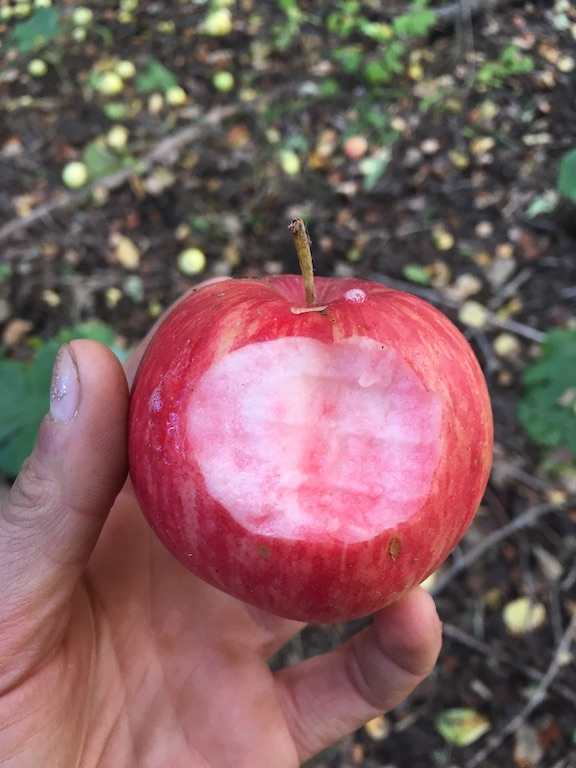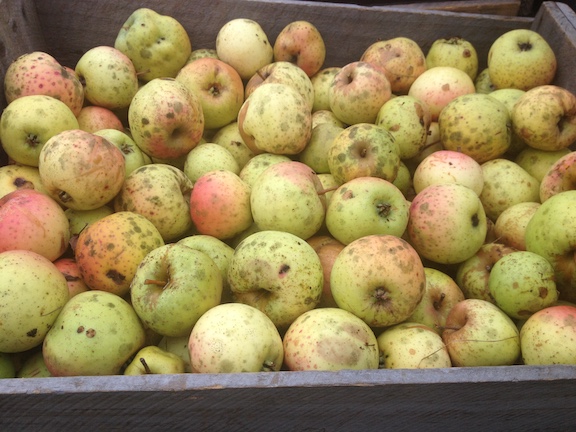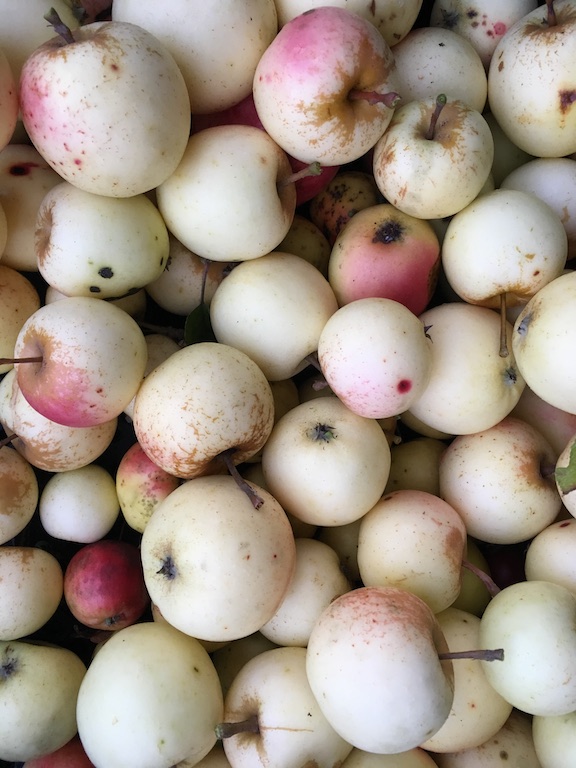By Jacob Mentlik
“Most fruits which we prize and use depend entirely on our care … but the apple emulates man’s
independence and enterprise … making its way amid the aboriginal trees.”
-Henry David Thoreau
It is believed that the origin of the apples we all know and love can be traced back to south central Asia, where wild apple (Malus sieversii) trees still grow densely in the Mountains of Kazakhstan. From here apples migrated along the Silk Road with traders, perhaps hybridizing with other Malus species (such as Malus sylvestris) along the way, and landed in Europe by the 12th century. Slowly, as choice selections with desirable traits were propagated through grafting and grown in cultivated settings, apple species continued to crossbreed and developed into the larger, palatable table fruit that we now know as Malus domestica. Apples became a beloved part of the culture through cooking and cider making and eventually made their way across the Atlantic Ocean to the North American continent with missionaries and colonists in the 17th century.

While there are a handful of crabapple species native to North America, including Malus coronaria and Malus ioensis, the arrival of apple seeds with Europeans diversified the gene pool and sparked the cultivation of apples by colonists and Indigenous peoples alike. Tribes such as the Pequot in what is now known as Connecticut and the Seneca Nation in what is now New York established extensive seedling apple orchards. Apples grew in popularity among colonists who relied upon the hardy fruit for winter sustenance and for making fermented cider. In the early 19th century the Homestead Act required settlers to plant 50 apple trees in order to maintain a claim to their property, and with the help of John Chapman (“Johnny Appleseed”) and other nurserymen, apple trees spread to the western frontier. The North American continent proved to be a favorable place for apple trees to grow and seeds were further dispersed across the landscape by birds and mammals.
Apples are now naturalized and grow in a variety of habitats including woodland edges, abandoned orchards and homesteads, and along fencerows and roadsides. These untended trees may have sprouted from seeds deposited by wildlife or from a discarded core tossed out a car window, or may even be forgotten grafted orchard trees surviving in an overgrown field or old house site. In fact, many of our favorite heirloom apples such as Northern Spy and Newtown Pippin were discovered as chance seedlings growing like this in the wild. The name “Pippin” actually refers to an ungrafted or wild apple grown from a seed.
Apples are heterozygous meaning that, just like humans, each offspring (or seedling) retains traits from both of its parents and is genetically unique. Even with the same two parents, each seedling apple can have a variety of different traits, resulting in infinite possibilities for novel apples. Furthermore, trees can cross-pollinate from more than 100 feet apart from each other. Without DNA testing, you never truly know who the parents are. Unlike modern apples such as Honeycrisp and Cortland that are intentionally bred using two known parents, wild apples are a gamble. Universities and experimental stations that conduct apple breeding operations often select genes from the same pool of parents again and again due to their predictable characteristics and mild flavors. In his essay “Wild Apples,” Henry David Thoreau described such apples as “very tame and forgettable … with comparatively little zest, and … no real tang nor smack to them.”
Wild apples on the other hand offer a whole world of flavor possibilities. It is these strong flavors present in wild apples that made them so popular for use in fermented cider. Often referred to as “spitters” because they are unpalatable for fresh eating, wild apples with bitter tannins and sharp acids make the most flavorful cider. As Thoreau says, “wild flavors of the Muse, vivacious and inspiriting.” The long history of cider making in European countries such as England and France led to the cultivation of many select bittersweet and sharp apples such Yarlington Mill, Kingston Black and Medaille d’Or. However in North America most cider was made from wild apples.

In recent years there has been a renaissance of cider making in the United States, leading to a newfound interest in wild apples. Abbey and Angus Dieghan from Rocky Ground Cider create some of the best fermented cider made from Maine wild apples. For years they have been foraging and collecting fruit from wild trees near their corner of Newburgh, Maine, and beyond, and blending it with heirloom fruit to create balanced, dry and complex ciders. For instance, Rocky Ground’s “Pips” cider contains “39 wild pippins and 8 heirloom varieties, all grown without fertilizer, irrigation or spray.” In recent years Abbey and Angus have begun to expand upon their own orchard, including many trees grafted from some of their favorite wild apple discoveries such as Triple Pink, Freight Train and Pixie Sweet.
In addition to their often intense and unique flavors, wild apples are also often hardier and better adapted to local conditions than cultivars from afar. In his book “Uncultivated,” which is “dedicated to the wild apple trees,” artist and cider maker Andy Brennan praises apple trees for their tenacity and

ability to withstand the various pressures of nature when left to their own devices, with little to no intervention from humans. Wild apple trees must face the challenges of drought, pests and disease without sprays, fertilizers or irrigation.
The South Orchard at the MOFGA fairgrounds is a no-spray zone, where we are experimenting with grafting wild apple selections onto the existing orchard trees to see how they fare without much management in a more cultivated but nevertheless low-intervention environment. Wild apple discoveries such as I-95, Green Kerr, and Rusty Knickers have been found to produce good quality fruit on their own and we hope that those characteristics will translate into an orchard setting.
Wild apples are not the perfectly manicured fruit we are accustomed to finding on the shelves at the grocery store. They can be gnarly, with nicks, bumps, bruises and bites, and may be small and oddly shaped. But they are beautiful, useful, flavorful and worthy of our attention. Foraging for wild apples is rewarding and fun. In addition to fall, May is a great time to scout for wild apple trees as their early spring blossoms stand out in the landscape. When fruit begins to ripen in September and October, the bounty of wild apples is up for grabs. As Thoreau says, “This chance wild fruit, planted by a cow or a bird on some remote and rocky hill-side, where it is as yet unobserved by man, may be the choicest of all its kind.” Keep your eyes peeled, you may just find the next Northern Spy!
For further reading, check out: “Wild Apples” by Henry David Thoreau, “Uncultivated: Wild Apples, Real Cider, and the Complicated Art of Making a Living” by Andy Brennan, “The Wild Apple Forager’s Guide” by Matt Kaminsky and “Proceedings from the First Annual Wild & Seedling Pomological Exhibition” by Matt Kaminsky.
Jacob Mentlik is a nurseryman, orchardist and homesteader living at After the Fall Farm in Montville, Maine. He is also the scionwood coordinator for Fedco Trees and helps research and care for the trees at the Maine Heritage Orchard.
